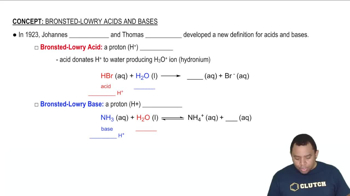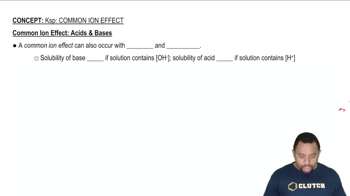Baking soda (sodium bicarbonate, NaHCO3) reacts with acids in foods to form carbonic acid (H2CO3), which in turn decomposes to water and carbon dioxide gas. In a cake batter, the CO2(g) forms bubbles and causes the cake to rise. (a) A rule of thumb in baking is that 1/2 teaspoon of baking soda is neutralized by one cup of sour milk. The acid component in sour milk is lactic acid, CH3CH(OH)COOH. Write the chemical equation for this neutralization reaction.
In nonaqueous solvents, it is possible to react HF to create H2F+. Which of these statements follows from this observation? (a) HF can act like a strong acid in nonaqueous solvents, (b) HF can act like a base in nonaqueous solvents, (c) HF is thermodynamically unstable, (d) There is an acid in the nonaqueous medium that is a stronger acid than HF.
 Verified step by step guidance
Verified step by step guidance
Verified video answer for a similar problem:
Key Concepts
Acid-Base Theory

Solvent Effects on Acidity

Thermodynamic Stability

Baking soda (sodium bicarbonate, NaHCO3) reacts with acids in foods to form carbonic acid (H2CO3), which in turn decomposes to water and carbon dioxide gas. In a cake batter, the CO2(g) forms bubbles and causes the cake to rise. (b) The density of baking soda is 2.16 g/cm3. Calculate the concentration of lactic acid in one cup of sour milk (assuming the rule of thumb applies), in units of mol/L. (One cup = 236.6 mL = 48 teaspoons).
Baking soda (sodium bicarbonate, NaHCO3) reacts with acids in foods to form carbonic acid (H2CO3), which in turn decomposes to water and carbon dioxide gas. In a cake batter, the CO2(g) forms bubbles and causes the cake to rise. (c) If 1/2 teaspoon of baking soda is indeed completely neutralized by the lactic acid in sour milk, calculate the volume of carbon dioxide gas that would be produced at 1 atm pressure, in an oven set to 350 F.
